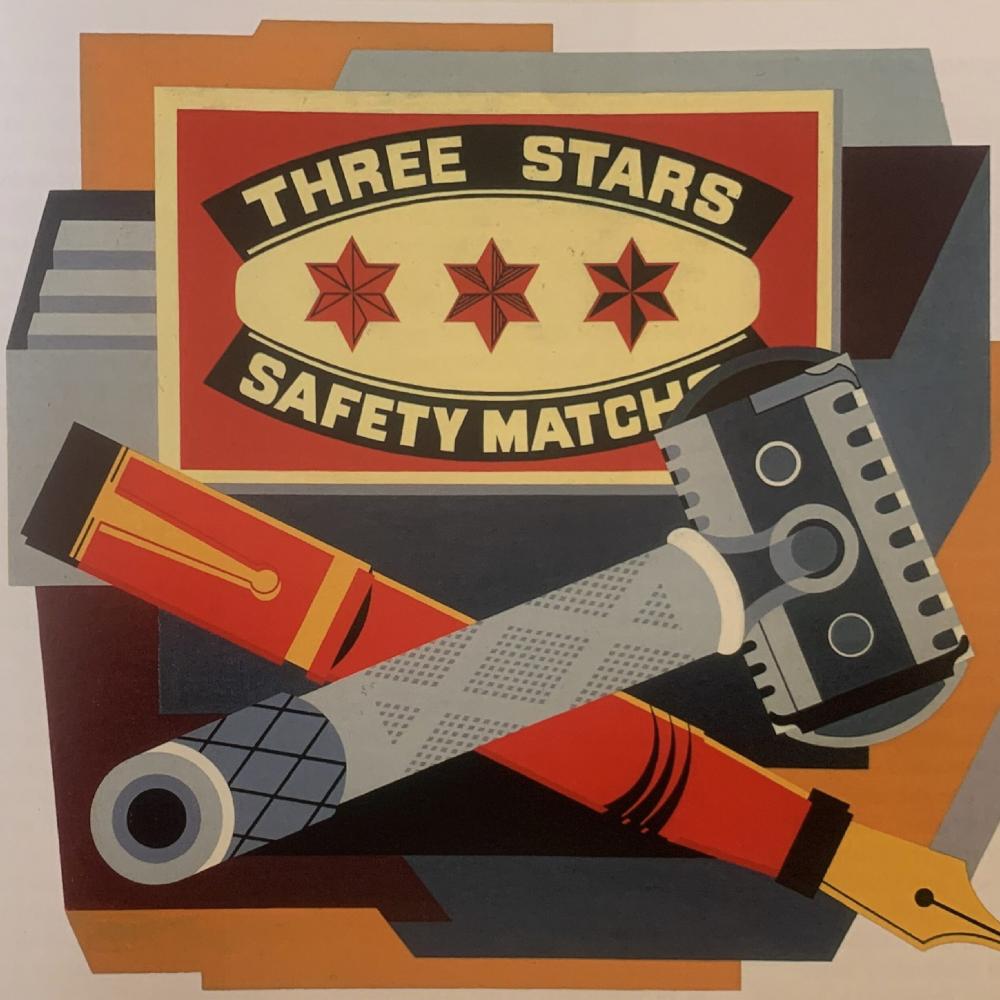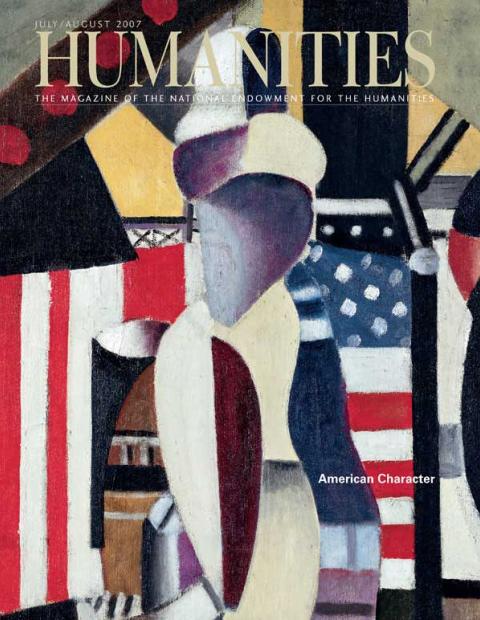In June 1921, Gerald and Sara Murphy and their three children sailed to France. They planned a tour of European gardens related to Gerald’s study of landscape architecture. But in Europe, instead of grand gardens, the couple found fecund ground for personal reinvention.
In Paris, Gerald became captivated by cubism. “There was a shock of recognition which put me into an entirely new orbit,” he said after visiting avant-garde art galleries. He rapidly gained fame as a distinctly American cubist painter, developing in seven years a small body of paintings now regarded as major works of American modernism.
At the same time, he and Sara enthralled their new artist friends with their genius for transforming daily life into art. Fernand Léger’s watercolors chronicled their summers on the Cote d’Azur. Pablo Picasso celebrated their seaside idylls with drawings that rendered Sara and her companions as classical figures.
On both sides of the Atlantic, the Murphys’ gift for friendships encouraged artistic breakthroughs and inspired major literary works by F. Scott Fitzgerald, Ernest Hemingway, Archibald MacLeish, and John Dos Passos. “Many of their friends remembered their time with the Murphys as the best years of their lives,” says Deborah Rothschild, senior curator of Modern and Contemporary Art at the Williams College Museum of Art.
Rothschild has created the first exhibition to explore the pivotal contribution of the Murphys to the emergence of modernism, “Making It New: The Art and Style of Sara and Gerald Murphy.” The NEH-funded exhibition opens July 8 at the Williams College Museum of Art in Williamstown, Massachusetts, and later will travel to the Yale University Art Gallery in New Haven and the Dallas Museum of Art.
The exhibition juxtaposes more than eighty artworks with approximately two hundred pieces of memorabilia. Amid paintings by Gerald, Picasso, Léger, Juan Gris, Le Corbusier, and others are manuscripts, letters, home movies, and photographs of family and friends.
The exhibition illuminates the Murphys’ influence on the literature, music, theater, dance, and visual art of their time, when, in the wake of World War I, artists in Europe were striving to create a new order out of postwar chaos. They drew from classical forms as well as the functional elegance of machinery, turbines, and ocean liners. In America, a young nation in ascent, the European avant-garde found a verve and freshness that propelled their passion for the new.
The avant-garde shuttling between Paris and New York via ocean liner had their own name, transatlantiques, and it was they who began creating art unlike anything Europe had seen.
During the Twenties, Gerald and Sara Murphy were the quintessential Americans in Paris: They thrived on the symbiosis between the French appetite for all things American and their desire for a life free from the stifling world of New York society.
The exhibition follows the couple from their early years, courtship, and marriage through their life in France to the 1930s and beyond, when they again lived in the United States.
The first section introduces Sara, a grand niece of William Tecumseh Sherman and daughter of Cincinnati ink manufacturer and self-made millionaire Frank Wiborg.
Sara and her two sisters were great beauties much in demand at society events. They frequented Europe with their mother and spent summers at the family’s thirty-room beachfront estate, the Dunes, in East Hampton, Long Island. A talented artist, Sara studied with William Merritt Chase at the Art Students League. Her watercolors and sketches are on view, as well as her engagement picture on the cover of a 1915 issue of Town & Country. Photographs show Sara steering a yacht, riding an elephant in India, and dancing in the surf with Gerald at the Dunes.
“You and I outdoors have been in such close touch,” Sara wrote to Gerald in 1915. “. . . I never dreamt I’d find someone whom the same things would delight. . . . We will always be able to get the most ecstatic joy out of the simplest, bottomest things . . .”
Gerald was the shy, handsome son of a merchant who had turned a Boston saddlery into the Mark Cross Company, a luxury goods business that he expanded into Manhattan. Patrick Murphy Sr. had little use for the aesthetic leanings of his son, who studied literature and the arts at Yale and was voted best-dressed man of the Class of 1912.
After Gerald completed his World War I service in the U.S. Signal Corps, the couple and their children—Honoria, Baoth, and Patrick—lived briefly in Cambridge, where Gerald was studying landscape architecture at Harvard.
In Europe, Sara’s fluency in French, German, and Italian and Gerald’s keen interest in design allowed the elegant couple to mingle easily with artists who gathered in Paris. They renovated an old flat overlooking the Seine into a sleek home with glossy black floors and bare white walls.
But the Murphys’ participation went far beyond style. In Paris galleries, Gerald saw cubist paintings by Picasso, Braque, Gris, Léger, and others, an experience that galvanized him into becoming an artist. “If that’s painting,” he later wrote of his first encounter with cubism, “that’s the kind of painting that I would like to do.”
Helping futurist Natalia Goncharova paint her set designs for Serge Diaghilev’s Ballets Russes, the couple soon joined the circle of painters, poets, dancers, and musicians who were collaborating on groundbreaking theatrical productions. The Murphys celebrated the July 1, 1923, premier of Igor Stravinsky’s ballet Les Noces with a legendary party in a barge restaurant on the Seine. Guests included Picasso, Darius Milhaud, Diaghilev, and Jean Cocteau. On display is an enlargement of a party menu signed by nearly all in attendance. Stravinsky wrote, “This is the most beautiful night of my life since my First Communion.”
The exhibition devotes a section to the theatrical projects of the Murphys and their friends. Les Ballets Suédois invited Gerald to create the libretto, scenery, and costumes for a production that became the first American jazz ballet. He enlisted his Yale classmate Cole Porter to write the music. Entitled Within the Quota, the lighthearted satire of immigration restrictions spoofed American capitalism, prudery, consumerism, and celebrity scandals. The ballet debuted in Paris on October 15, 1923. A video shows the 1999 revival by the Royal Swedish Opera.
Meanwhile, Gerald quickly absorbed the principles of cubism, which he applied to images of his own life and American popular culture.
Although immediately praised by European artists, Gerald’s works only gained recognition in the United States decades later.
Working meticulously on each painting, Gerald produced fourteen between 1922 and 1929. The exhibition presents all seven of his surviving works along with reproductions of three lost originals.
At the 1923 show of the Salon des Independants, Gerald’s eighteen-foot-tall canvas Boat Deck dwarfed the surrounding works by French cubists. His billboard-scale art deco rendering of an ocean liner’s smoke stacks created a sensation.
At the following year’s show, Gerald exhibited Razor, which crosses giant images of a pen and razor—products that his father might sell—in a composition that resembles a heraldic shield.
His bold paintings transform images of turbines, watches, and American consumer products into art of iconic power. Anticipating pop art, Gerald’s paintings break the boundary between everyday objects and art as Andy Warhol and Jasper Johns would do decades later.
“Real objects which I admired had become for me abstractions,” Gerald wrote later.
Bringing art to daily life, at Cap d’Antibes, the Murphys created a simulated American setting at a beachfront compound they named “Villa America.” They replaced the villa’s traditional mansard roof with a deck that became the setting for daylong parties that transported the ebullient beach life of East Hampton summers to the Cote d’Azur.
As Wanda Corn writes in her book on early American modernism, The Great American Thing, Gerald “performed his nativeness on the French stage of both art and life.”
At Villa America, the Murphys created their own society, mingling European artists with American writers early in their careers. The Murphys supported their young friends with connections, guidance, and financial aid. But, as Rothschild writes in the exhibition catalog, “. . . what made them memorable and inspiring to writers and artists was an aesthetic infrastructure—as ordered and labored over as Gerald’s paintings—on top of which they improvised daily.”
A perfectionist, Gerald carefully orchestrated daily events, outfitted in his beach costume of espadrilles, a striped sailor jersey, and knitted fisherman’s cap. The sight of Gerald making cocktails reminded playwright Philip Barry of a priest celebrating Mass. While some guests preferred to lounge on the beach, others joined Gerald in a kinetic round of activities that included gymnastics, yoga, dance, canoeing, swimming, and sailing on the Murphy schooner, Weatherbird, named for a composition by jazz musician Joe “King” Oliver.
The Murphys’ vigorous open-air lifestyle inspired its own satire, a musical, Le Train Bleu, named for the train that brought Parisians to the Cote d’Azur. A film shows the 1993 Paris Opera Ballet revival of the production, which the Ballets Russes premiered on June 20, 1924. Darius Milhaud wrote the score, Jean Cocteau devised the scenario, Coco Chanel designed the costumes, and the backdrop—two women running on the beach—was by Picasso.
Although the Murphys cultivated a star-power guest list, their exuberant celebrations had a daily grace grounded in familial love and friendships. “Unlike the world both had come from, where children were shunted to the care of nannies,” says Rothschild, “family life and children were the center of their lives.”
Alongside photographs of beach parties is a reproduction of the Murphys’ Salon de la Jeunesse, a wall showcasing their children’s drawings and watercolors.
Tragedy severed these golden years. In 1929, the year of the stock market crash that set off the Depression, the Murphys’ youngest child, Patrick, contracted tuberculosis. The family cared for their son at sanatoriums in New York and Switzerland, surrounding him with friends and art. In 1935, their robust son Baoth contracted meningitis and died at 16. Two years later, at 16, Patrick succumbed to his disease. On view are drawings that Léger and Patrick made of each other a week before the boy’s death.
Picasso’s early classical studies of the Murphys seem prophetic, striking at a deeper truth—the stoicism underlying their effervescent lifestyle. They bore their anguish with grace, and their mutual devotion survived a period of estrangement. Soon after the death of Baoth, Sara wrote to a friend, “Don’t ever ever relinquish the truth that children—one’s own children—are the things that matter most in life—(Even if the husband or wife problem should be complicated or difficult).” Ten days later, she wrote, “We try to think only of the simple things like children, and flowers, and puppies, and food—and so may find our balance again—and our friends have been an unforgettable help throughout.”
“Sara and Gerald had extraordinary character and generosity of spirit,” says Rothschild, who read all of their letters. “They are exemplars of a virtuous, well-lived life.”
By the mid-Thirties, the Murphys were back in New York for good. Gerald’s years as an artist behind him, he ably revived the family business. On view is the overnight case he designed for Grace Kelly in Rear Window and a 1941 photo of his Manhattan storefront, where, instead of luxury goods, Gerald displayed photos of his blacked-out factory in England to protest America’s isolation from the war in Europe.
Among the memorabilia of their later years is correspondence between Gerald and F. Scott Fitzgerald. “Life itself has stepped in now and blundered, scarred and destroyed,” Gerald wrote. “In my heart I dreaded the moment when our youth and invention would be attacked in our only vulnerable spot—the children.”
Fitzgerald wrote in reply, “The golden bowl is broken indeed, but it was golden.”


